Coles Monopoly: Analyzing Inefficiencies & Government Intervention
VerifiedAdded on 2023/04/21
|10
|2522
|215
Essay
AI Summary
This essay examines the monopoly power of Coles Supermarket in the Australian retail industry, focusing on the inefficiencies that arise from its market dominance and the interventions employed by the Australian government to mitigate these issues. It begins by defining monopoly and its characteristics, highlighting how Coles Supermarket has achieved a significant market share through acquisitions and economies of scale. The essay then delves into the negative impacts of this monopoly, including increased prices, reduced consumer choice, and potential compromises in product quality. Furthermore, it explores the government's attempts to curb Coles' power through neo-liberal policies, revised merger policies, financial support for small businesses, and price controls, analyzing the effectiveness of these measures. The essay also provides an economic analysis of the monopoly, illustrating how Coles maintains supernormal profits and the deadweight loss created by its market position. It concludes that while the government has taken steps to address the monopoly, further action may be needed to ensure a more competitive and efficient market.
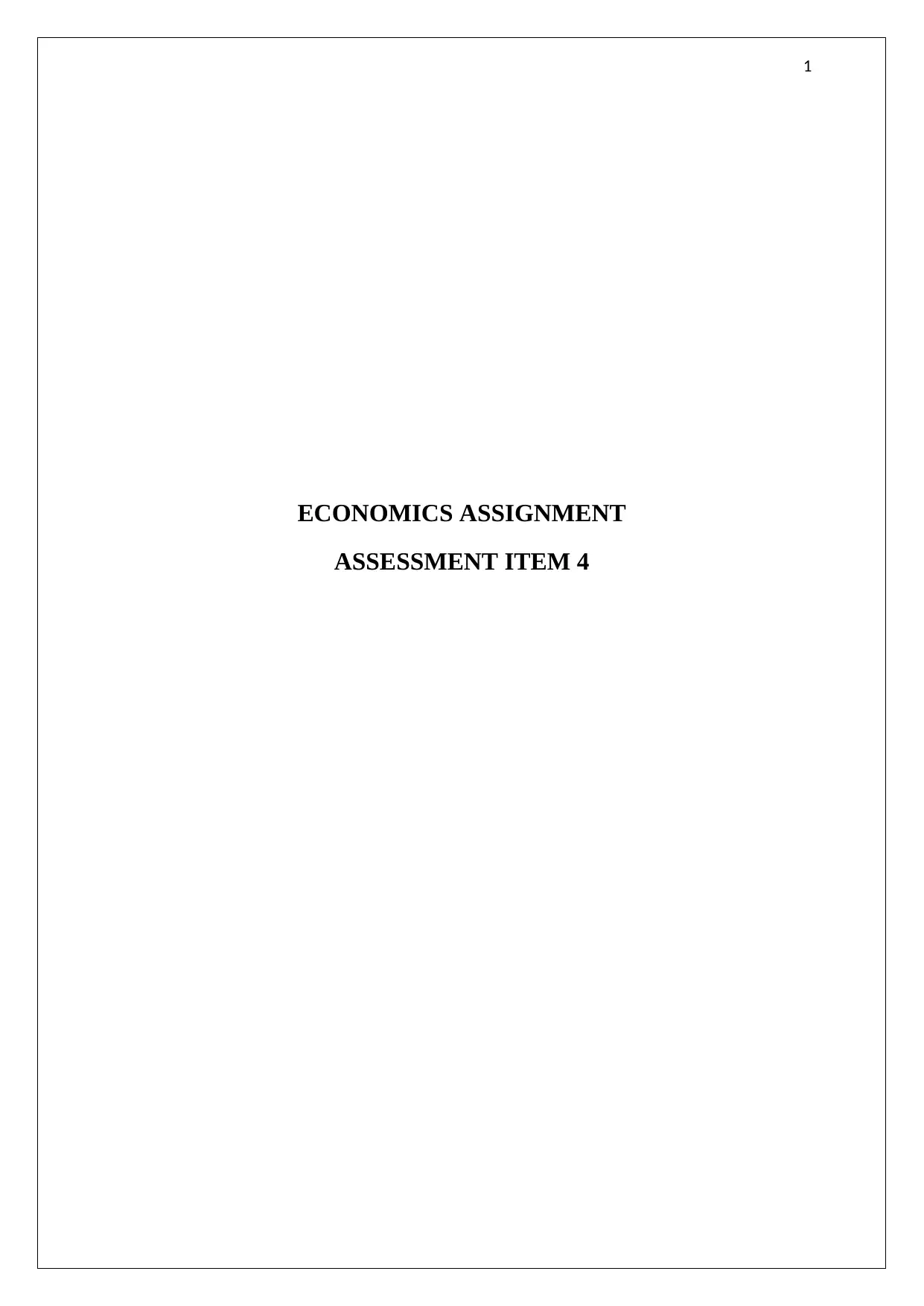
1
ECONOMICS ASSIGNMENT
ASSESSMENT ITEM 4
ECONOMICS ASSIGNMENT
ASSESSMENT ITEM 4
Paraphrase This Document
Need a fresh take? Get an instant paraphrase of this document with our AI Paraphraser
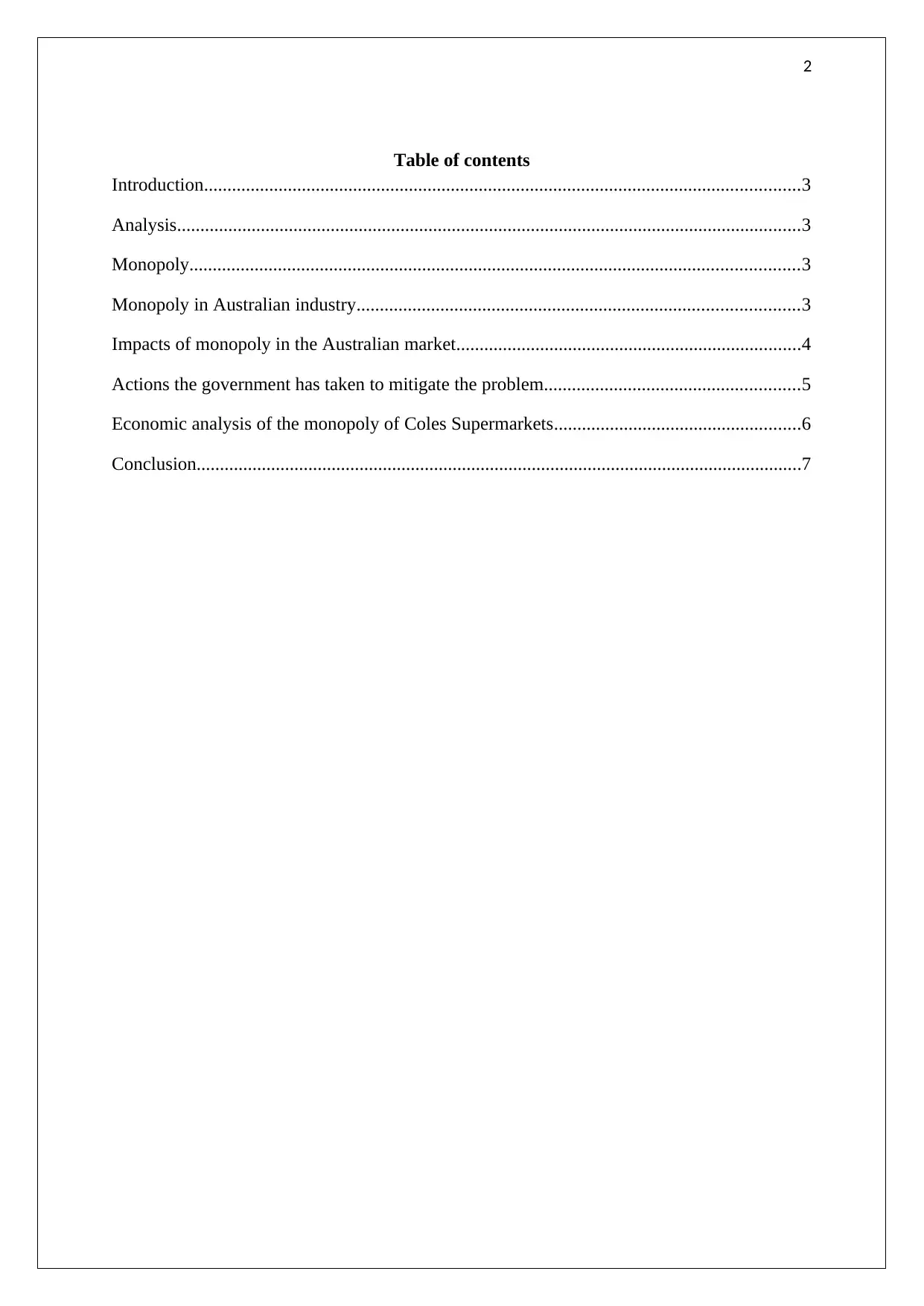
2
Table of contents
Introduction................................................................................................................................3
Analysis......................................................................................................................................3
Monopoly...................................................................................................................................3
Monopoly in Australian industry...............................................................................................3
Impacts of monopoly in the Australian market..........................................................................4
Actions the government has taken to mitigate the problem.......................................................5
Economic analysis of the monopoly of Coles Supermarkets.....................................................6
Conclusion..................................................................................................................................7
Table of contents
Introduction................................................................................................................................3
Analysis......................................................................................................................................3
Monopoly...................................................................................................................................3
Monopoly in Australian industry...............................................................................................3
Impacts of monopoly in the Australian market..........................................................................4
Actions the government has taken to mitigate the problem.......................................................5
Economic analysis of the monopoly of Coles Supermarkets.....................................................6
Conclusion..................................................................................................................................7
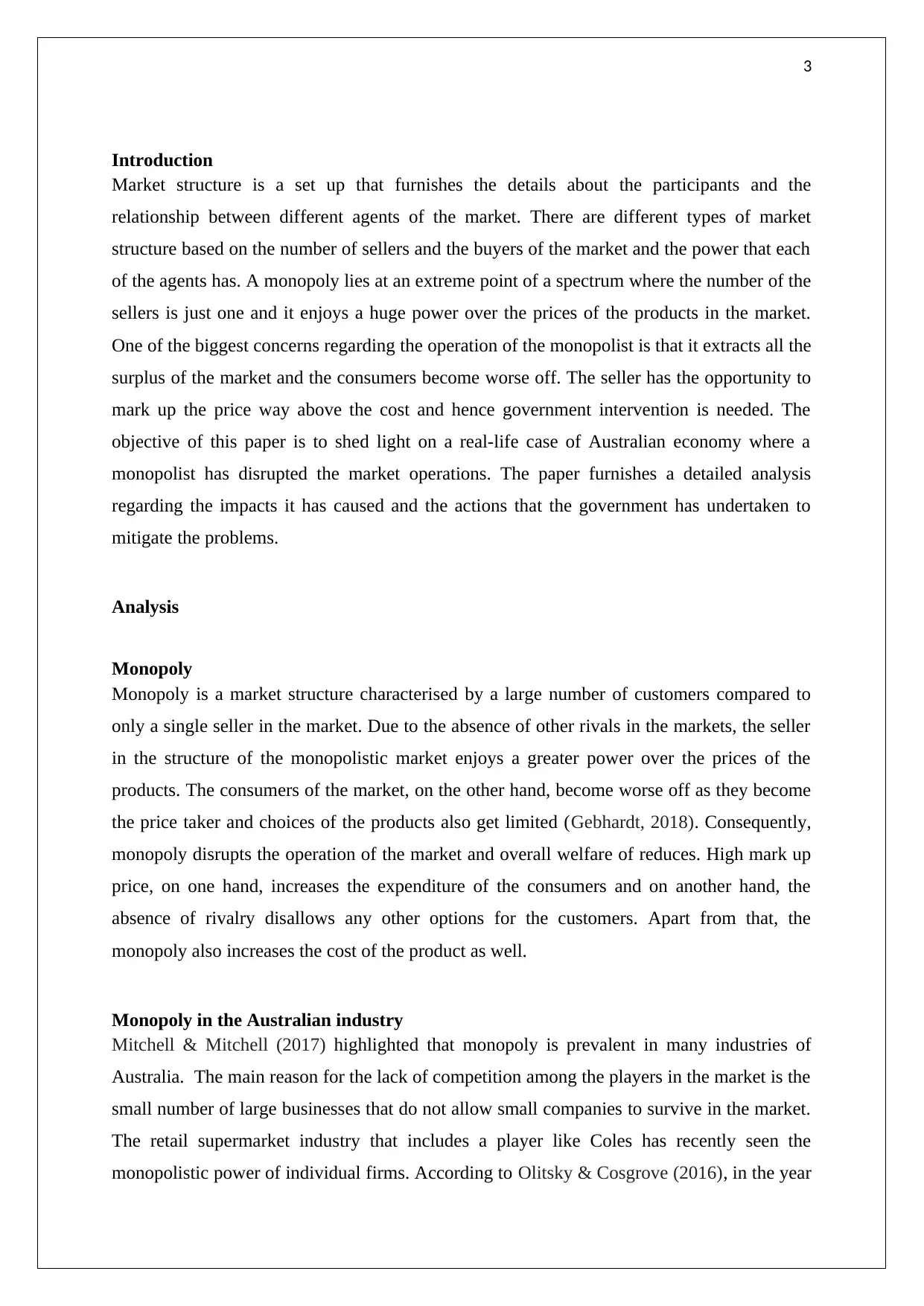
3
Introduction
Market structure is a set up that furnishes the details about the participants and the
relationship between different agents of the market. There are different types of market
structure based on the number of sellers and the buyers of the market and the power that each
of the agents has. A monopoly lies at an extreme point of a spectrum where the number of the
sellers is just one and it enjoys a huge power over the prices of the products in the market.
One of the biggest concerns regarding the operation of the monopolist is that it extracts all the
surplus of the market and the consumers become worse off. The seller has the opportunity to
mark up the price way above the cost and hence government intervention is needed. The
objective of this paper is to shed light on a real-life case of Australian economy where a
monopolist has disrupted the market operations. The paper furnishes a detailed analysis
regarding the impacts it has caused and the actions that the government has undertaken to
mitigate the problems.
Analysis
Monopoly
Monopoly is a market structure characterised by a large number of customers compared to
only a single seller in the market. Due to the absence of other rivals in the markets, the seller
in the structure of the monopolistic market enjoys a greater power over the prices of the
products. The consumers of the market, on the other hand, become worse off as they become
the price taker and choices of the products also get limited (Gebhardt, 2018). Consequently,
monopoly disrupts the operation of the market and overall welfare of reduces. High mark up
price, on one hand, increases the expenditure of the consumers and on another hand, the
absence of rivalry disallows any other options for the customers. Apart from that, the
monopoly also increases the cost of the product as well.
Monopoly in the Australian industry
Mitchell & Mitchell (2017) highlighted that monopoly is prevalent in many industries of
Australia. The main reason for the lack of competition among the players in the market is the
small number of large businesses that do not allow small companies to survive in the market.
The retail supermarket industry that includes a player like Coles has recently seen the
monopolistic power of individual firms. According to Olitsky & Cosgrove (2016), in the year
Introduction
Market structure is a set up that furnishes the details about the participants and the
relationship between different agents of the market. There are different types of market
structure based on the number of sellers and the buyers of the market and the power that each
of the agents has. A monopoly lies at an extreme point of a spectrum where the number of the
sellers is just one and it enjoys a huge power over the prices of the products in the market.
One of the biggest concerns regarding the operation of the monopolist is that it extracts all the
surplus of the market and the consumers become worse off. The seller has the opportunity to
mark up the price way above the cost and hence government intervention is needed. The
objective of this paper is to shed light on a real-life case of Australian economy where a
monopolist has disrupted the market operations. The paper furnishes a detailed analysis
regarding the impacts it has caused and the actions that the government has undertaken to
mitigate the problems.
Analysis
Monopoly
Monopoly is a market structure characterised by a large number of customers compared to
only a single seller in the market. Due to the absence of other rivals in the markets, the seller
in the structure of the monopolistic market enjoys a greater power over the prices of the
products. The consumers of the market, on the other hand, become worse off as they become
the price taker and choices of the products also get limited (Gebhardt, 2018). Consequently,
monopoly disrupts the operation of the market and overall welfare of reduces. High mark up
price, on one hand, increases the expenditure of the consumers and on another hand, the
absence of rivalry disallows any other options for the customers. Apart from that, the
monopoly also increases the cost of the product as well.
Monopoly in the Australian industry
Mitchell & Mitchell (2017) highlighted that monopoly is prevalent in many industries of
Australia. The main reason for the lack of competition among the players in the market is the
small number of large businesses that do not allow small companies to survive in the market.
The retail supermarket industry that includes a player like Coles has recently seen the
monopolistic power of individual firms. According to Olitsky & Cosgrove (2016), in the year
⊘ This is a preview!⊘
Do you want full access?
Subscribe today to unlock all pages.

Trusted by 1+ million students worldwide
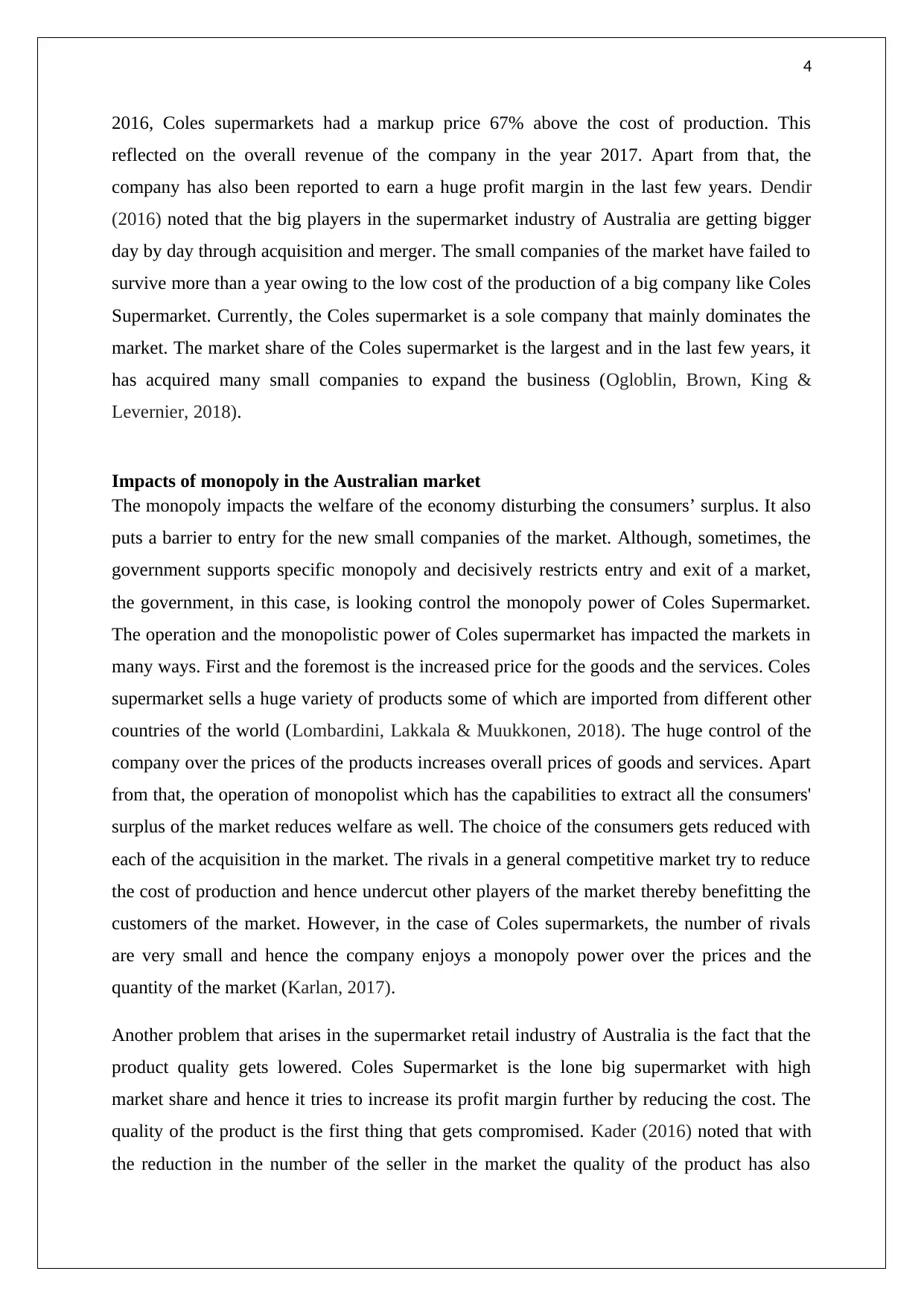
4
2016, Coles supermarkets had a markup price 67% above the cost of production. This
reflected on the overall revenue of the company in the year 2017. Apart from that, the
company has also been reported to earn a huge profit margin in the last few years. Dendir
(2016) noted that the big players in the supermarket industry of Australia are getting bigger
day by day through acquisition and merger. The small companies of the market have failed to
survive more than a year owing to the low cost of the production of a big company like Coles
Supermarket. Currently, the Coles supermarket is a sole company that mainly dominates the
market. The market share of the Coles supermarket is the largest and in the last few years, it
has acquired many small companies to expand the business (Ogloblin, Brown, King &
Levernier, 2018).
Impacts of monopoly in the Australian market
The monopoly impacts the welfare of the economy disturbing the consumers’ surplus. It also
puts a barrier to entry for the new small companies of the market. Although, sometimes, the
government supports specific monopoly and decisively restricts entry and exit of a market,
the government, in this case, is looking control the monopoly power of Coles Supermarket.
The operation and the monopolistic power of Coles supermarket has impacted the markets in
many ways. First and the foremost is the increased price for the goods and the services. Coles
supermarket sells a huge variety of products some of which are imported from different other
countries of the world (Lombardini, Lakkala & Muukkonen, 2018). The huge control of the
company over the prices of the products increases overall prices of goods and services. Apart
from that, the operation of monopolist which has the capabilities to extract all the consumers'
surplus of the market reduces welfare as well. The choice of the consumers gets reduced with
each of the acquisition in the market. The rivals in a general competitive market try to reduce
the cost of production and hence undercut other players of the market thereby benefitting the
customers of the market. However, in the case of Coles supermarkets, the number of rivals
are very small and hence the company enjoys a monopoly power over the prices and the
quantity of the market (Karlan, 2017).
Another problem that arises in the supermarket retail industry of Australia is the fact that the
product quality gets lowered. Coles Supermarket is the lone big supermarket with high
market share and hence it tries to increase its profit margin further by reducing the cost. The
quality of the product is the first thing that gets compromised. Kader (2016) noted that with
the reduction in the number of the seller in the market the quality of the product has also
2016, Coles supermarkets had a markup price 67% above the cost of production. This
reflected on the overall revenue of the company in the year 2017. Apart from that, the
company has also been reported to earn a huge profit margin in the last few years. Dendir
(2016) noted that the big players in the supermarket industry of Australia are getting bigger
day by day through acquisition and merger. The small companies of the market have failed to
survive more than a year owing to the low cost of the production of a big company like Coles
Supermarket. Currently, the Coles supermarket is a sole company that mainly dominates the
market. The market share of the Coles supermarket is the largest and in the last few years, it
has acquired many small companies to expand the business (Ogloblin, Brown, King &
Levernier, 2018).
Impacts of monopoly in the Australian market
The monopoly impacts the welfare of the economy disturbing the consumers’ surplus. It also
puts a barrier to entry for the new small companies of the market. Although, sometimes, the
government supports specific monopoly and decisively restricts entry and exit of a market,
the government, in this case, is looking control the monopoly power of Coles Supermarket.
The operation and the monopolistic power of Coles supermarket has impacted the markets in
many ways. First and the foremost is the increased price for the goods and the services. Coles
supermarket sells a huge variety of products some of which are imported from different other
countries of the world (Lombardini, Lakkala & Muukkonen, 2018). The huge control of the
company over the prices of the products increases overall prices of goods and services. Apart
from that, the operation of monopolist which has the capabilities to extract all the consumers'
surplus of the market reduces welfare as well. The choice of the consumers gets reduced with
each of the acquisition in the market. The rivals in a general competitive market try to reduce
the cost of production and hence undercut other players of the market thereby benefitting the
customers of the market. However, in the case of Coles supermarkets, the number of rivals
are very small and hence the company enjoys a monopoly power over the prices and the
quantity of the market (Karlan, 2017).
Another problem that arises in the supermarket retail industry of Australia is the fact that the
product quality gets lowered. Coles Supermarket is the lone big supermarket with high
market share and hence it tries to increase its profit margin further by reducing the cost. The
quality of the product is the first thing that gets compromised. Kader (2016) noted that with
the reduction in the number of the seller in the market the quality of the product has also
Paraphrase This Document
Need a fresh take? Get an instant paraphrase of this document with our AI Paraphraser
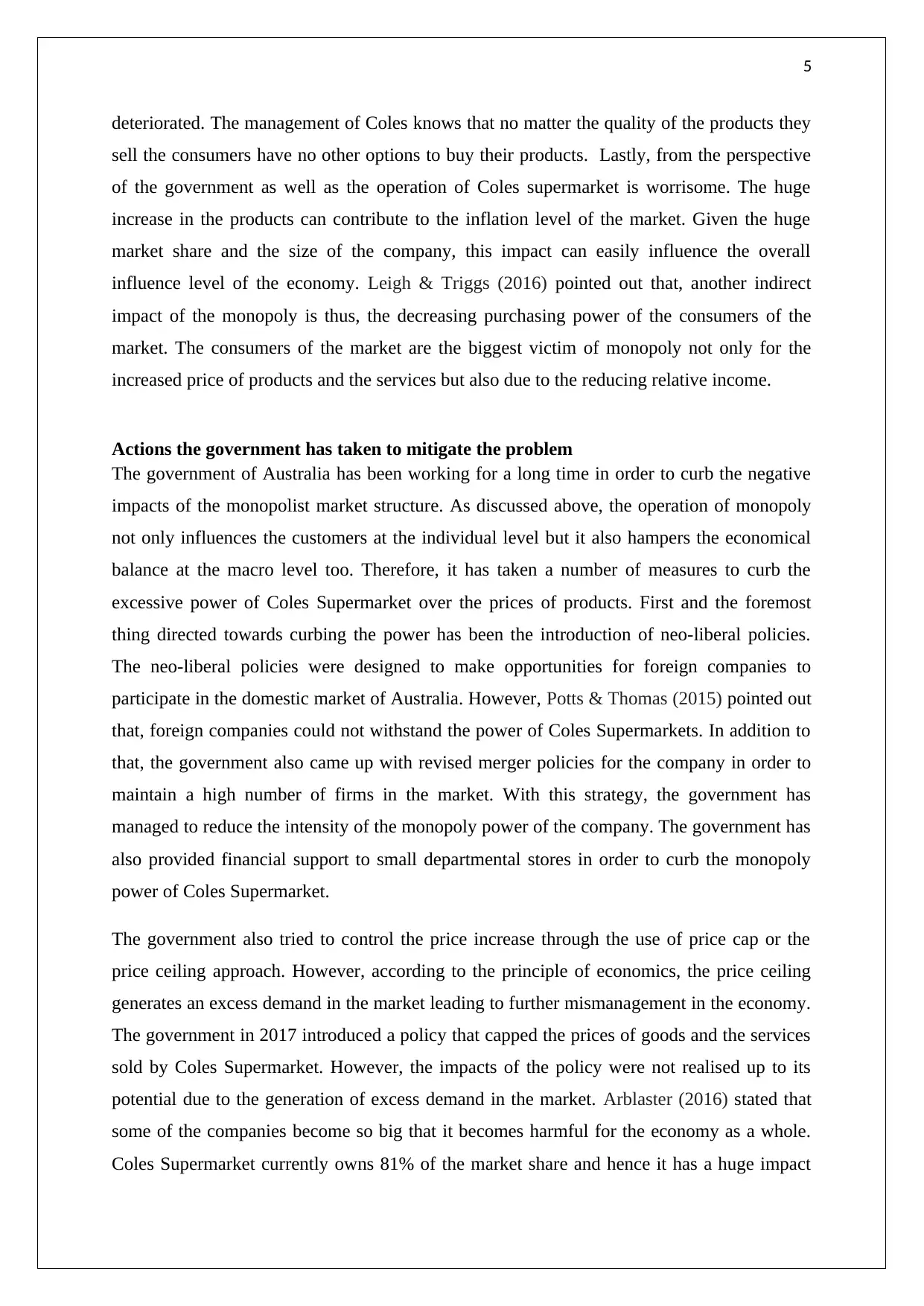
5
deteriorated. The management of Coles knows that no matter the quality of the products they
sell the consumers have no other options to buy their products. Lastly, from the perspective
of the government as well as the operation of Coles supermarket is worrisome. The huge
increase in the products can contribute to the inflation level of the market. Given the huge
market share and the size of the company, this impact can easily influence the overall
influence level of the economy. Leigh & Triggs (2016) pointed out that, another indirect
impact of the monopoly is thus, the decreasing purchasing power of the consumers of the
market. The consumers of the market are the biggest victim of monopoly not only for the
increased price of products and the services but also due to the reducing relative income.
Actions the government has taken to mitigate the problem
The government of Australia has been working for a long time in order to curb the negative
impacts of the monopolist market structure. As discussed above, the operation of monopoly
not only influences the customers at the individual level but it also hampers the economical
balance at the macro level too. Therefore, it has taken a number of measures to curb the
excessive power of Coles Supermarket over the prices of products. First and the foremost
thing directed towards curbing the power has been the introduction of neo-liberal policies.
The neo-liberal policies were designed to make opportunities for foreign companies to
participate in the domestic market of Australia. However, Potts & Thomas (2015) pointed out
that, foreign companies could not withstand the power of Coles Supermarkets. In addition to
that, the government also came up with revised merger policies for the company in order to
maintain a high number of firms in the market. With this strategy, the government has
managed to reduce the intensity of the monopoly power of the company. The government has
also provided financial support to small departmental stores in order to curb the monopoly
power of Coles Supermarket.
The government also tried to control the price increase through the use of price cap or the
price ceiling approach. However, according to the principle of economics, the price ceiling
generates an excess demand in the market leading to further mismanagement in the economy.
The government in 2017 introduced a policy that capped the prices of goods and the services
sold by Coles Supermarket. However, the impacts of the policy were not realised up to its
potential due to the generation of excess demand in the market. Arblaster (2016) stated that
some of the companies become so big that it becomes harmful for the economy as a whole.
Coles Supermarket currently owns 81% of the market share and hence it has a huge impact
deteriorated. The management of Coles knows that no matter the quality of the products they
sell the consumers have no other options to buy their products. Lastly, from the perspective
of the government as well as the operation of Coles supermarket is worrisome. The huge
increase in the products can contribute to the inflation level of the market. Given the huge
market share and the size of the company, this impact can easily influence the overall
influence level of the economy. Leigh & Triggs (2016) pointed out that, another indirect
impact of the monopoly is thus, the decreasing purchasing power of the consumers of the
market. The consumers of the market are the biggest victim of monopoly not only for the
increased price of products and the services but also due to the reducing relative income.
Actions the government has taken to mitigate the problem
The government of Australia has been working for a long time in order to curb the negative
impacts of the monopolist market structure. As discussed above, the operation of monopoly
not only influences the customers at the individual level but it also hampers the economical
balance at the macro level too. Therefore, it has taken a number of measures to curb the
excessive power of Coles Supermarket over the prices of products. First and the foremost
thing directed towards curbing the power has been the introduction of neo-liberal policies.
The neo-liberal policies were designed to make opportunities for foreign companies to
participate in the domestic market of Australia. However, Potts & Thomas (2015) pointed out
that, foreign companies could not withstand the power of Coles Supermarkets. In addition to
that, the government also came up with revised merger policies for the company in order to
maintain a high number of firms in the market. With this strategy, the government has
managed to reduce the intensity of the monopoly power of the company. The government has
also provided financial support to small departmental stores in order to curb the monopoly
power of Coles Supermarket.
The government also tried to control the price increase through the use of price cap or the
price ceiling approach. However, according to the principle of economics, the price ceiling
generates an excess demand in the market leading to further mismanagement in the economy.
The government in 2017 introduced a policy that capped the prices of goods and the services
sold by Coles Supermarket. However, the impacts of the policy were not realised up to its
potential due to the generation of excess demand in the market. Arblaster (2016) stated that
some of the companies become so big that it becomes harmful for the economy as a whole.
Coles Supermarket currently owns 81% of the market share and hence it has a huge impact
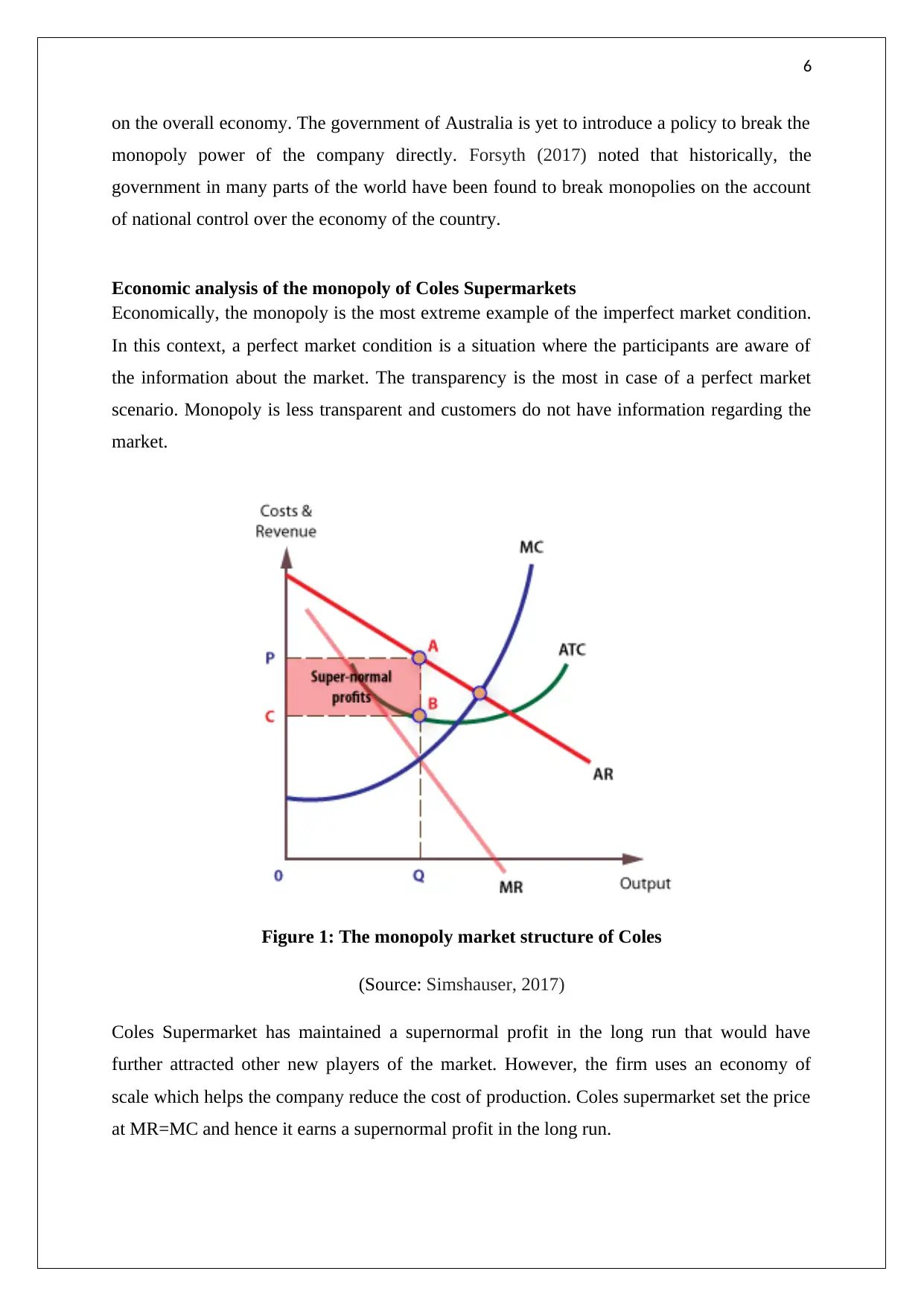
6
on the overall economy. The government of Australia is yet to introduce a policy to break the
monopoly power of the company directly. Forsyth (2017) noted that historically, the
government in many parts of the world have been found to break monopolies on the account
of national control over the economy of the country.
Economic analysis of the monopoly of Coles Supermarkets
Economically, the monopoly is the most extreme example of the imperfect market condition.
In this context, a perfect market condition is a situation where the participants are aware of
the information about the market. The transparency is the most in case of a perfect market
scenario. Monopoly is less transparent and customers do not have information regarding the
market.
Figure 1: The monopoly market structure of Coles
(Source: Simshauser, 2017)
Coles Supermarket has maintained a supernormal profit in the long run that would have
further attracted other new players of the market. However, the firm uses an economy of
scale which helps the company reduce the cost of production. Coles supermarket set the price
at MR=MC and hence it earns a supernormal profit in the long run.
on the overall economy. The government of Australia is yet to introduce a policy to break the
monopoly power of the company directly. Forsyth (2017) noted that historically, the
government in many parts of the world have been found to break monopolies on the account
of national control over the economy of the country.
Economic analysis of the monopoly of Coles Supermarkets
Economically, the monopoly is the most extreme example of the imperfect market condition.
In this context, a perfect market condition is a situation where the participants are aware of
the information about the market. The transparency is the most in case of a perfect market
scenario. Monopoly is less transparent and customers do not have information regarding the
market.
Figure 1: The monopoly market structure of Coles
(Source: Simshauser, 2017)
Coles Supermarket has maintained a supernormal profit in the long run that would have
further attracted other new players of the market. However, the firm uses an economy of
scale which helps the company reduce the cost of production. Coles supermarket set the price
at MR=MC and hence it earns a supernormal profit in the long run.
⊘ This is a preview!⊘
Do you want full access?
Subscribe today to unlock all pages.

Trusted by 1+ million students worldwide
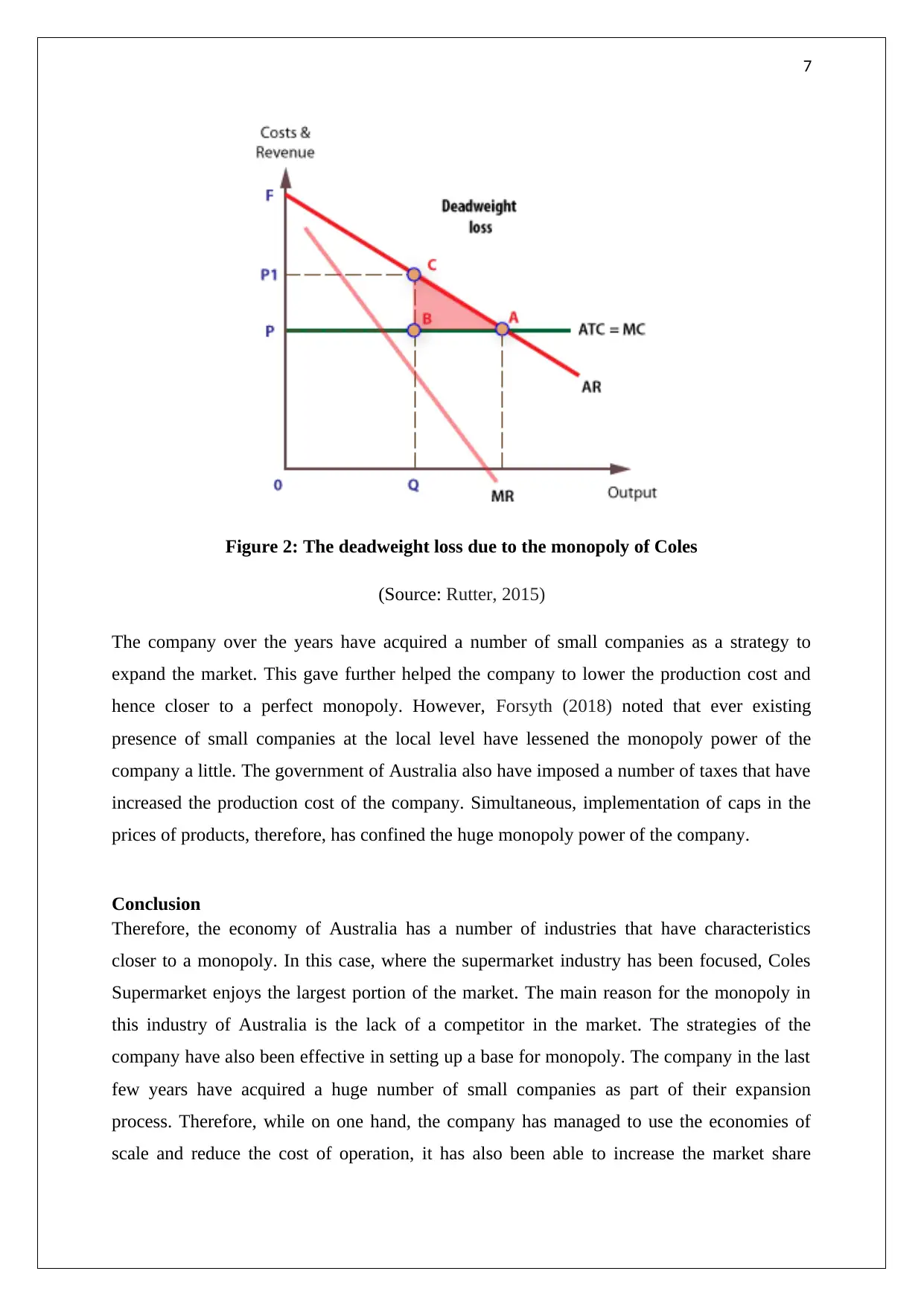
7
Figure 2: The deadweight loss due to the monopoly of Coles
(Source: Rutter, 2015)
The company over the years have acquired a number of small companies as a strategy to
expand the market. This gave further helped the company to lower the production cost and
hence closer to a perfect monopoly. However, Forsyth (2018) noted that ever existing
presence of small companies at the local level have lessened the monopoly power of the
company a little. The government of Australia also have imposed a number of taxes that have
increased the production cost of the company. Simultaneous, implementation of caps in the
prices of products, therefore, has confined the huge monopoly power of the company.
Conclusion
Therefore, the economy of Australia has a number of industries that have characteristics
closer to a monopoly. In this case, where the supermarket industry has been focused, Coles
Supermarket enjoys the largest portion of the market. The main reason for the monopoly in
this industry of Australia is the lack of a competitor in the market. The strategies of the
company have also been effective in setting up a base for monopoly. The company in the last
few years have acquired a huge number of small companies as part of their expansion
process. Therefore, while on one hand, the company has managed to use the economies of
scale and reduce the cost of operation, it has also been able to increase the market share
Figure 2: The deadweight loss due to the monopoly of Coles
(Source: Rutter, 2015)
The company over the years have acquired a number of small companies as a strategy to
expand the market. This gave further helped the company to lower the production cost and
hence closer to a perfect monopoly. However, Forsyth (2018) noted that ever existing
presence of small companies at the local level have lessened the monopoly power of the
company a little. The government of Australia also have imposed a number of taxes that have
increased the production cost of the company. Simultaneous, implementation of caps in the
prices of products, therefore, has confined the huge monopoly power of the company.
Conclusion
Therefore, the economy of Australia has a number of industries that have characteristics
closer to a monopoly. In this case, where the supermarket industry has been focused, Coles
Supermarket enjoys the largest portion of the market. The main reason for the monopoly in
this industry of Australia is the lack of a competitor in the market. The strategies of the
company have also been effective in setting up a base for monopoly. The company in the last
few years have acquired a huge number of small companies as part of their expansion
process. Therefore, while on one hand, the company has managed to use the economies of
scale and reduce the cost of operation, it has also been able to increase the market share
Paraphrase This Document
Need a fresh take? Get an instant paraphrase of this document with our AI Paraphraser
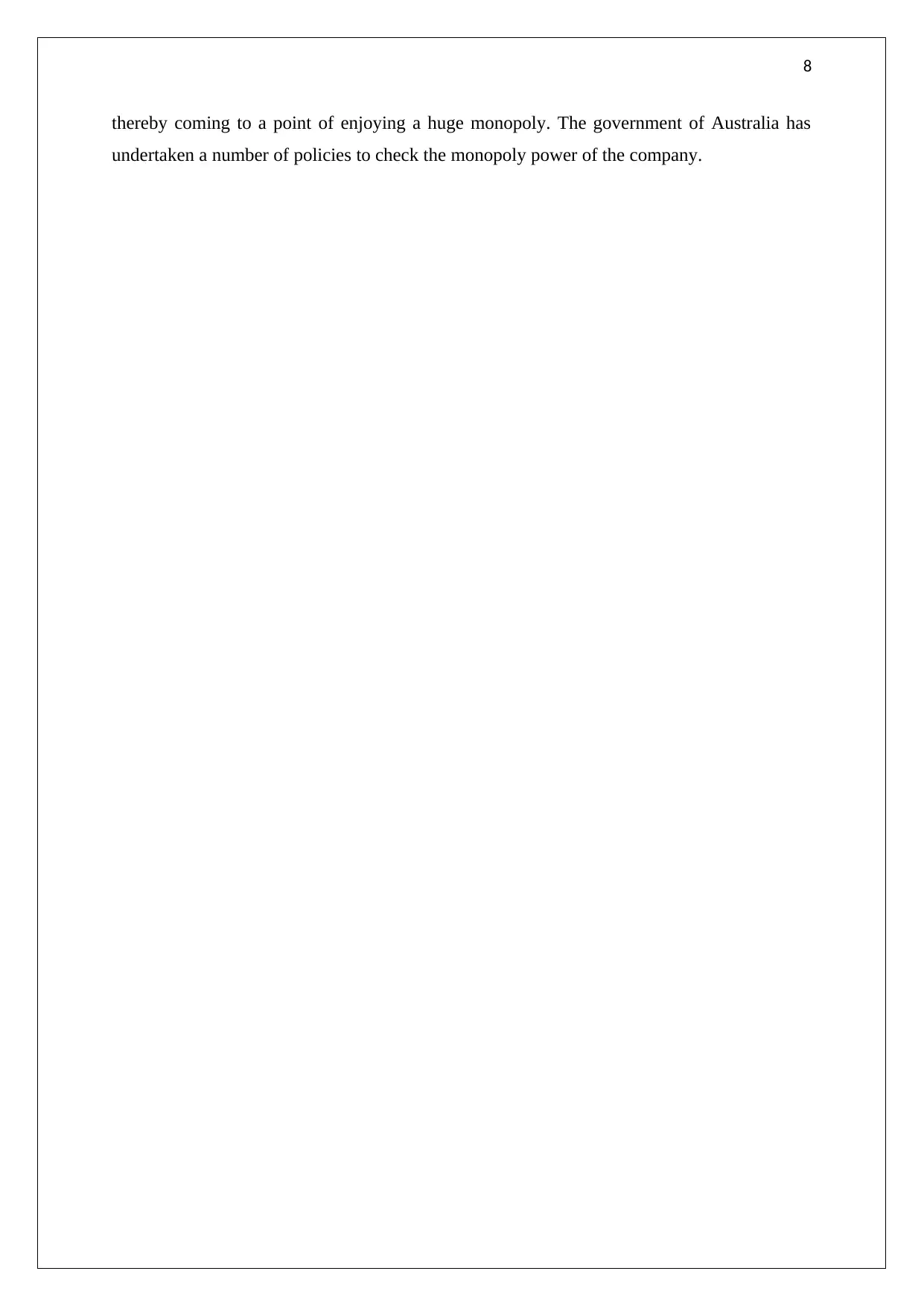
8
thereby coming to a point of enjoying a huge monopoly. The government of Australia has
undertaken a number of policies to check the monopoly power of the company.
thereby coming to a point of enjoying a huge monopoly. The government of Australia has
undertaken a number of policies to check the monopoly power of the company.
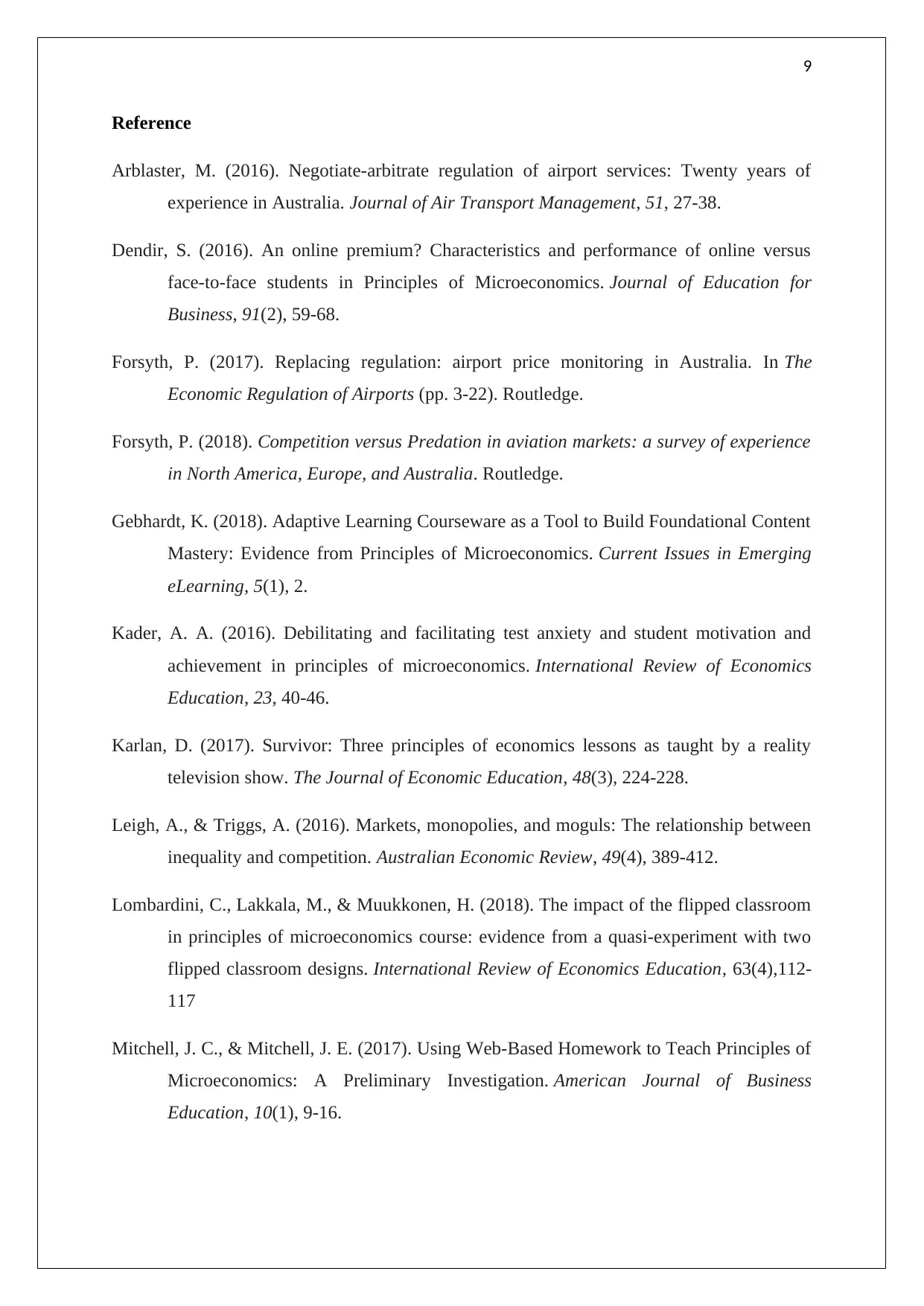
9
Reference
Arblaster, M. (2016). Negotiate-arbitrate regulation of airport services: Twenty years of
experience in Australia. Journal of Air Transport Management, 51, 27-38.
Dendir, S. (2016). An online premium? Characteristics and performance of online versus
face-to-face students in Principles of Microeconomics. Journal of Education for
Business, 91(2), 59-68.
Forsyth, P. (2017). Replacing regulation: airport price monitoring in Australia. In The
Economic Regulation of Airports (pp. 3-22). Routledge.
Forsyth, P. (2018). Competition versus Predation in aviation markets: a survey of experience
in North America, Europe, and Australia. Routledge.
Gebhardt, K. (2018). Adaptive Learning Courseware as a Tool to Build Foundational Content
Mastery: Evidence from Principles of Microeconomics. Current Issues in Emerging
eLearning, 5(1), 2.
Kader, A. A. (2016). Debilitating and facilitating test anxiety and student motivation and
achievement in principles of microeconomics. International Review of Economics
Education, 23, 40-46.
Karlan, D. (2017). Survivor: Three principles of economics lessons as taught by a reality
television show. The Journal of Economic Education, 48(3), 224-228.
Leigh, A., & Triggs, A. (2016). Markets, monopolies, and moguls: The relationship between
inequality and competition. Australian Economic Review, 49(4), 389-412.
Lombardini, C., Lakkala, M., & Muukkonen, H. (2018). The impact of the flipped classroom
in principles of microeconomics course: evidence from a quasi-experiment with two
flipped classroom designs. International Review of Economics Education, 63(4),112-
117
Mitchell, J. C., & Mitchell, J. E. (2017). Using Web-Based Homework to Teach Principles of
Microeconomics: A Preliminary Investigation. American Journal of Business
Education, 10(1), 9-16.
Reference
Arblaster, M. (2016). Negotiate-arbitrate regulation of airport services: Twenty years of
experience in Australia. Journal of Air Transport Management, 51, 27-38.
Dendir, S. (2016). An online premium? Characteristics and performance of online versus
face-to-face students in Principles of Microeconomics. Journal of Education for
Business, 91(2), 59-68.
Forsyth, P. (2017). Replacing regulation: airport price monitoring in Australia. In The
Economic Regulation of Airports (pp. 3-22). Routledge.
Forsyth, P. (2018). Competition versus Predation in aviation markets: a survey of experience
in North America, Europe, and Australia. Routledge.
Gebhardt, K. (2018). Adaptive Learning Courseware as a Tool to Build Foundational Content
Mastery: Evidence from Principles of Microeconomics. Current Issues in Emerging
eLearning, 5(1), 2.
Kader, A. A. (2016). Debilitating and facilitating test anxiety and student motivation and
achievement in principles of microeconomics. International Review of Economics
Education, 23, 40-46.
Karlan, D. (2017). Survivor: Three principles of economics lessons as taught by a reality
television show. The Journal of Economic Education, 48(3), 224-228.
Leigh, A., & Triggs, A. (2016). Markets, monopolies, and moguls: The relationship between
inequality and competition. Australian Economic Review, 49(4), 389-412.
Lombardini, C., Lakkala, M., & Muukkonen, H. (2018). The impact of the flipped classroom
in principles of microeconomics course: evidence from a quasi-experiment with two
flipped classroom designs. International Review of Economics Education, 63(4),112-
117
Mitchell, J. C., & Mitchell, J. E. (2017). Using Web-Based Homework to Teach Principles of
Microeconomics: A Preliminary Investigation. American Journal of Business
Education, 10(1), 9-16.
⊘ This is a preview!⊘
Do you want full access?
Subscribe today to unlock all pages.

Trusted by 1+ million students worldwide
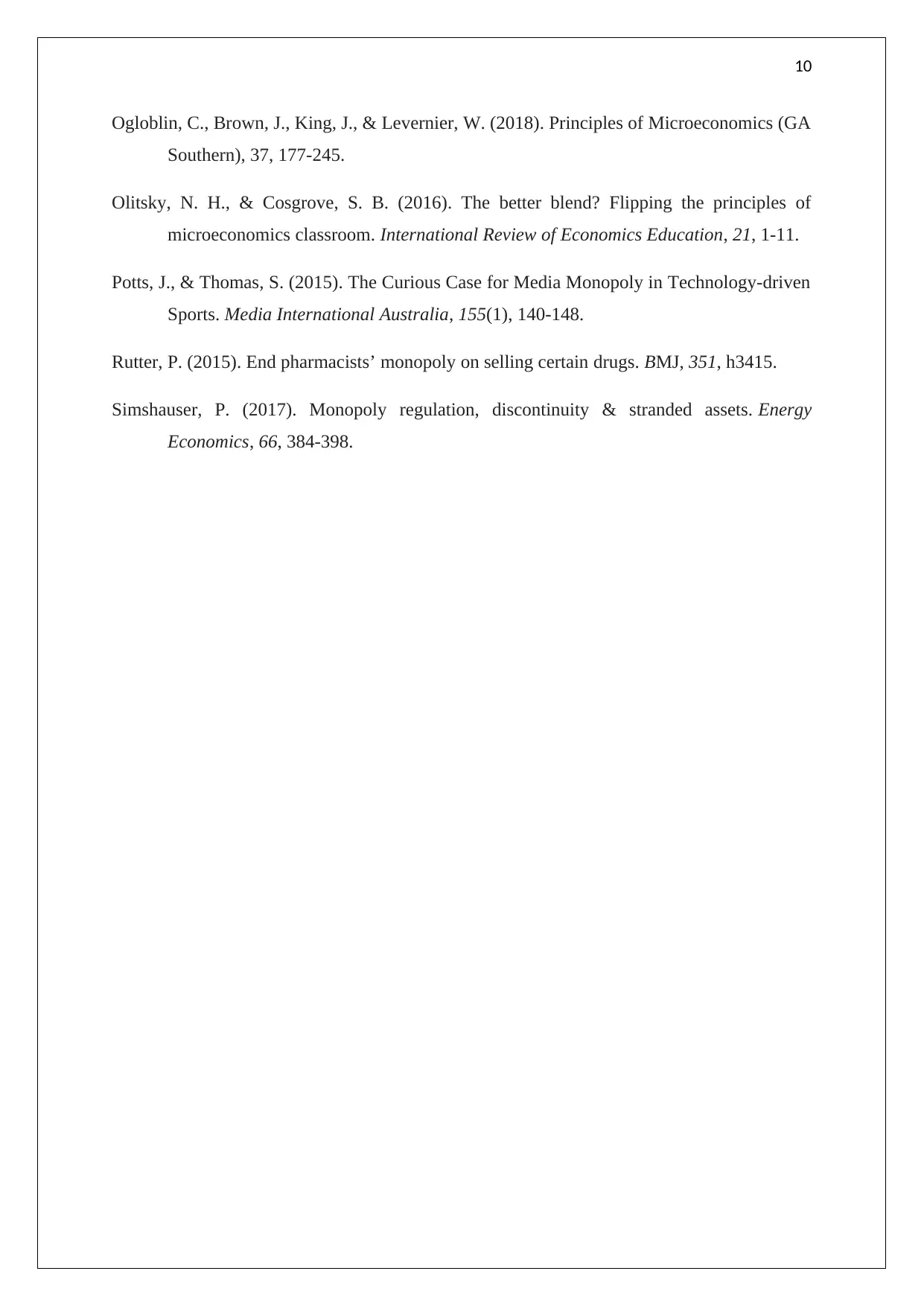
10
Ogloblin, C., Brown, J., King, J., & Levernier, W. (2018). Principles of Microeconomics (GA
Southern), 37, 177-245.
Olitsky, N. H., & Cosgrove, S. B. (2016). The better blend? Flipping the principles of
microeconomics classroom. International Review of Economics Education, 21, 1-11.
Potts, J., & Thomas, S. (2015). The Curious Case for Media Monopoly in Technology-driven
Sports. Media International Australia, 155(1), 140-148.
Rutter, P. (2015). End pharmacists’ monopoly on selling certain drugs. BMJ, 351, h3415.
Simshauser, P. (2017). Monopoly regulation, discontinuity & stranded assets. Energy
Economics, 66, 384-398.
Ogloblin, C., Brown, J., King, J., & Levernier, W. (2018). Principles of Microeconomics (GA
Southern), 37, 177-245.
Olitsky, N. H., & Cosgrove, S. B. (2016). The better blend? Flipping the principles of
microeconomics classroom. International Review of Economics Education, 21, 1-11.
Potts, J., & Thomas, S. (2015). The Curious Case for Media Monopoly in Technology-driven
Sports. Media International Australia, 155(1), 140-148.
Rutter, P. (2015). End pharmacists’ monopoly on selling certain drugs. BMJ, 351, h3415.
Simshauser, P. (2017). Monopoly regulation, discontinuity & stranded assets. Energy
Economics, 66, 384-398.
1 out of 10
Related Documents
Your All-in-One AI-Powered Toolkit for Academic Success.
+13062052269
info@desklib.com
Available 24*7 on WhatsApp / Email
![[object Object]](/_next/static/media/star-bottom.7253800d.svg)
Unlock your academic potential
Copyright © 2020–2025 A2Z Services. All Rights Reserved. Developed and managed by ZUCOL.





